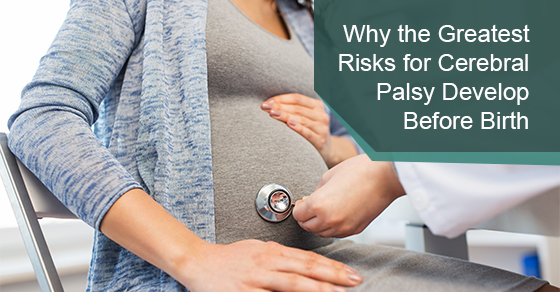Cerebral palsy, or CP, refers to abnormal development of the brain or damage to a developing brain that affects a child’s ability to control their muscles. CP affects body movement and posture, and it is one of the most common causes of long-term disability in children.
Many factors can increase the chances of an unborn child developing cerebral palsy. Understanding these risk factors and how pregnant mothers can lessen them can cause a dramatic reduction in the chances of a baby being born with cerebral palsy.
While the symptoms of cerebral palsy can range in severity, the condition does not worsen over time. It can be alleviated by physical therapy and other medical treatments, resulting in significant improvements.
Signs or symptoms of cerebral palsy can show themselves in infants or during preschool years. You might see impaired movements such as abnormal reflexes, floppiness or rigidity of the limbs and trunk, abnormal posture, involuntary movements, imbalance when walking or any combination of these.
If you have any questions or concerns regarding your child and a potential birth injury claim, please contact Sommers Roth & Elmaleh for a consultation with our experienced birth trauma lawyers in your province.
Pregnancy Risk Factors of Cerebral Palsy
Most risk factors associated with developing cerebral palsy do not occur during labour, as many individuals believe. They are a combination of many events or circumstances which occur during pregnancy. This article will discuss the different risk factors connected to the development of cerebral palsy and the prevention methods that can help expecting mothers minimize the chances of developing this life-altering condition.
Having the required knowledge of cerebral palsy’s risk factors will help parents know the warning signs to look out for and what prevention methods to take throughout pregnancy and delivery.
The following are more common risk factors or medical problems that can arise during pregnancy that can increase the probability of cerebral palsy:
Low Birth Rate or Premature Birth
Babies born weighing under 5 ½ pounds, especially those below 3 pounds, have a greater chance of developing cerebral palsy. Besides, infants born before the 37th week of pregnancy, especially before the 32nd week, have a higher chance of having cerebral palsy.
Multiple Births
Twins, triplets or other multiple births are at higher risk of one of the babies having cerebral palsy. The chances increase if one of the baby’s twins dies before birth or soon after birth. Part of the reason for this is because children born in multiple pregnancies are usually born early, underweight or both.
Infertility Treatments
Assisted reproductive technologies (ART) are available in many forms today. Many couples use ARTs to help them induce pregnancy. Children born from pregnancies caused by infertility treatments have a higher chance of having cerebral palsy. This is because the chances of having both preterm birth and multiple pregnancies are increased when utilizing ART infertility treatments.
Infections During Pregnancy
There are many potential infections that can occur during pregnancy. These infections lead to the production of proteins known as cytokines which circulate throughout a fetus’ blood and brain. These cause inflammation and can lead to brain damage in the fetus. Common pregnancy infections that are related to cerebral palsy include chickenpox, rubella, cytomegalovirus, maternal pelvic infections, toxoplasmosis and other bacterial infections.
Fever During Pregnancy
Fever in the expecting mother during pregnancy or delivery can cause a higher chance of the fetus developing brain damage, which can sometimes result in cerebral palsy.
Jaundice
Jaundice refers to the condition in which the baby has yellow-tinted skin and eyes. This serves as a warning signal for abnormal liver function in the infant. It is caused by an excess buildup of bilirubin and usually isn’t too serious. Problems arise when jaundice goes untreated and copious amounts of bilirubin create brain damage resulting in congenital disabilities like cerebral palsy.
Cerebral Palsy Prevention
It’s difficult for even the top medical practitioners to deduce the cause of congenital cerebral palsy, especially when genetics is an underlying risk factor. The positive news is that expecting mothers can make certain efforts before and during their pregnancy to ensure that they are healthy. These preventable actions can aid in avoiding developmental issues like cerebral palsy.
Before Pregnancy
- Esure that you are as healthy as possible while attempting to become pregnant, including getting treatment for health conditions or infections.
- Mothers should also be vaccinated against certain diseases like rubella and chickenpox before pregnancy.
- If using infertility treatments, then consider transferring only one embryo to reduce chances of twins or triplets.
During Pregnancy
- Familiarize yourself with healthy pregnancy practices.
- Always attend regular prenatal checkups.
- Get a flu shot.
- Do not hesitate to speak with your healthcare provider if you show signs of fever, sickness or infection.
- Make a habit of sanitizing your hands to avoid chances of incurring infection.
- If preterm delivery is in question, supplement with magnesium sulphate.
If your child was born with cerebral palsy and you are unsure how it occurred, you might require the help of a birth trauma law expert to get the answers you need. This information might be hidden by your medical practitioner to avoid any malpractice lawsuits.
To learn more about Cerebral Palsy and compensation, call Sommers Roth & Elmaleh at 1-844-777-7372 or contact us here.

